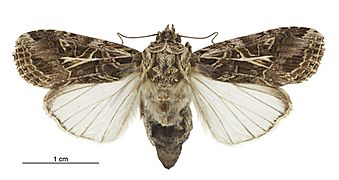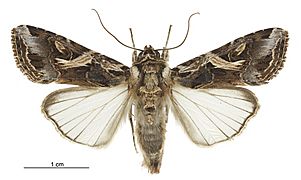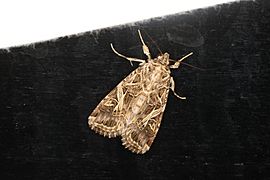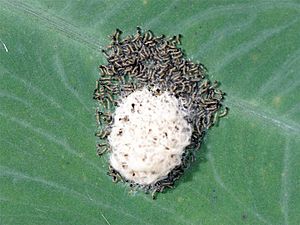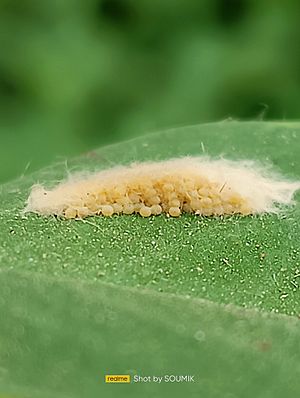Spodoptera litura facts for kids
Quick facts for kids Spodoptera litura |
|
|---|---|
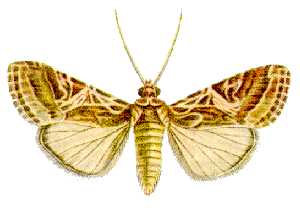 |
|
| Scientific classification | |
| Synonyms | |
|
The Spodoptera litura, also known as the tobacco cutworm or cotton leafworm, is a type of moth. These moths are active at night and belong to the family Noctuidae.
S. litura is a serious pest that eats many different kinds of plants, which is why it's called polyphagous. It's found in Asia, Oceania, and the Indian subcontinent. The scientist Johan Christian Fabricius first described this moth in 1775. Its common names, tobacco cutworm and cotton leafworm, come from two of the plants it often eats.
This moth can damage 87 types of plants that are important for farming. The young moths, called larvae or caterpillars, eat a lot, often destroying plant leaves completely. This can cause big problems for farmers, ruining crops and reducing how much food can be grown. Because of the harm they can do to many different crops and local farms, people work hard to control these pests.
S. litura is often mistaken for a close relative, Spodoptera littoralis. These two species look very much alike as both larvae and adult moths.
Contents
About the Tobacco Cutworm
Male and Female Differences
How They Look
There are small but clear differences in how male and female S. litura moths look. These differences help scientists tell them apart easily. The front wings of male moths are usually 14–17 mm long. Female moths have slightly larger front wings, measuring 15–18 mm. Males also have a more noticeable spot on their front wing.
How They Eat
Male and female moths eat differently, especially when it comes to important nutrients. When S. litura moths are given two food choices – one rich in protein and one rich in carbohydrates – females tend to eat more protein than males. They eat about the same amount of carbohydrates.
Females are very good at turning the protein they eat into body growth and mass. This is important because they need energy to produce eggs. Males, on the other hand, are better at storing fat from the carbohydrates they eat. This stored fat is like an energy reserve. Males often fly long distances to find females during mating season, and this stored energy helps them with their journey.
Similar Moths
Spodoptera litura and Spodoptera littoralis are very closely related. It can be hard to tell them apart because their young (larvae) and adult forms look the same. In fact, they are so similar that some old reports of S. litura in places like Russia, Germany, and the UK might have actually been S. littoralis.
Since both species eat many different plants, looking at the plant they are on doesn't help identify them. The only sure way to tell them apart is by looking closely at their sex organs. In S. littoralis, certain parts of the female sex organs are the same length. In S. litura, these parts are different lengths. For males, a part called the juxta has a unique shape for each species.
Where They Live
S. litura is most common in South Asia. However, it naturally lives in areas from the Oriental and Australasian regions to parts of the Palearctic region. Countries with many S. litura include China, Indonesia, India, Japan, and Malaysia.
These moths have also spread to new places through international trade. Eggs, larvae, or pupae (the stage before adult moths) can hide in soil, flowers, or plants that are shipped around the world. Pupae can travel long distances without being harmed because they stay in that stage for a while.
Their Home
S. litura is a general plant-eater and lives on many different plants. They can live in temperatures between 10 and 37 degrees Celsius. This means they do well in warm, tropical, and mild climate regions.
As caterpillars, S. litura can only move short distances. But adult moths can fly up to 1.5 km for about 4 hours. This helps the moths spread to new places and find different plants to eat when their old food sources run out.
Life Cycle

The length of a S. litura life cycle changes a little depending on the region. Typically, they complete 12 generations each year. Each generation lasts about a month, but temperature causes small changes. Life cycles are a bit longer than a month in winter and shorter than a month in summer.
Egg Stage
S. litura eggs are round and slightly flat. Each egg is about 0.6 mm wide and is orange-brown or pink. Females lay these eggs in large groups on the surface of leaves, with each group often having hundreds of eggs. A female moth can lay between 2000 and 2600 eggs in her lifetime. However, high temperatures and low humidity can reduce the number of eggs she lays.
When laid, the egg groups are covered with golden-brown hairs from the female moth. The entire egg mass is about 4–7 mm wide. The eggs hatch into larvae 2–3 days after being laid.
Larva Stage
The larvae, or caterpillars, range in length from 2.3 mm to 32 mm. Their color changes as they grow. Younger larvae are usually light green, while older ones become dark green or brown. A bright yellow stripe along their back is a key feature of these larvae. They also have no hair.
You can find newly hatched larvae by looking for scratch marks on plant leaves. Since S. litura is active at night, the larvae feed after dark. During the day, they usually hide in the soil around the plant. They go through six growth stages, called instars. By the last stage, a larva can weigh up to 800 mg.
Pupa Stage
The pupa stage lasts about 7 to 10 days. This stage happens in the soil near the bottom of the plant. The pupa is typically 15–20 mm long and is red-brown. A special feature is two small spines at the end of its body, each about 0.5 mm long.
Adult Stage
Adult moths are usually 15–20 mm long, and their wingspan (the distance from wingtip to wingtip) is about 30–38 mm. Their bodies are gray-brown. The front wings have patterns of dark gray, red, and brown. The back wings are grayish-white with a gray edge. Female moths live for about 8.3 days on average, while males live a bit longer, around 10.4 days.
Reproduction
Moths do not mate on the first night they become adults. However, about 70% of mating happens on the second night, which is when they are most active. Female moths mate about 3.1 times on average, while males mate about 10.3 times. Studies have shown that a female moth's life gets shorter after she mates. Scientists are still trying to understand why this happens.
Natural Enemies
There are 131 known natural enemies that prey on S. litura at different stages of its life. These include different types of parasites that specifically target the eggs, larvae, or pupae. Also, 36 species of insects and 12 species of spiders are known to hunt these moths. The types of predators can vary depending on where the moths live.
Moths can also get sick from fungi and viruses. The most common viruses found are nuclear polyhedrosis viruses and granulosis viruses. For example, in Karnataka, India, a granulosis virus was found in dead S. litura larvae. This virus could infect both eggs and larvae, causing 50% to 100% of them to die, with older larvae dying faster than younger ones.
Chemical Clues
Predators have many ways to find their prey. One way is by using chemical signals released by the larvae. These signals act like a locator for predators looking for food. For example, the stink bug Eocanthecona furcellata uses these chemical signals to find and catch S. litura larvae. The stink bug starts hunting when it smells two specific chemicals released by the larvae.
Host Plants
S. litura eats over 112 different plant species from more than 40 plant families. This makes them highly polyphagous, meaning they eat many kinds of plants. The larvae cause serious damage to their host plants because they eat so much. Some common plants they eat include tobacco, cotton, soybean, beet, cabbage, and chickpeas. When there isn't enough food on a plant in one area, large groups of larvae will move to find a new food source.
Interaction with Humans
Pest Problems
You can spot signs of S. litura pest activity by looking for large holes on leaves, damaged plant stems near the ground, and discolored leaves. Because S. litura harms many different farm crops, its presence can cause financial losses for farmers in areas where these crops are grown.
For example, S. litura has been responsible for a 71% loss in groundnut crops in southern India. Another example shows that S. litura can reduce tobacco yield by 23–50%. This can cause big economic problems because millions of people are involved in growing, selling, or transporting tobacco. The significant damage S. litura can cause to agriculture has led many countries, including the United States, to put it on their quarantine list. This means they try to stop it from entering their country.
Pest Control
Because S. litura affects many important farm crops, pesticides are often used against them all year round. However, this constant use has caused S. litura to quickly develop resistance to many pesticides and insecticides. Also, the large amount of pesticides used has raised concerns about chemical residues on food, harm to the environment, and the killing of helpful insects.
Because of these problems, recent research has focused on other natural ways to control these pests. One study is looking at using a fungus called Nomuraea rileyi on the larvae of this moth. In lab tests, spraying a solution of this fungus on larvae helped control the late second and early third stages of larvae on castor crops. When tested in fields, this fungal solution caused a very high death rate of 88–97% among larvae 19 days after it was applied.
See also
- Spodoptera littoralis
- African armyworm (Spodoptera exempta)


